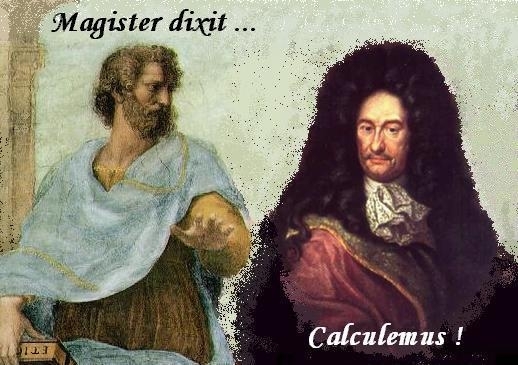 |
 |
This collage represents both great
logicians: Aristotle (384-322 BC), the creator of the Science of Logic,
and Gottfried Wilhelm von Leibniz (1646-1716), the first who transmuted
it into a mathematical discipline. They are pronouncing two winged phrases.
Magister
dixit ("The Master said it") is the scholastic conjuration reducing
any proof to Aristotle's authority (of course, he was not implicated in
the mediaeval speculations with his name). On the contrary, Calculemus!
("Let's calculate!") reflects Leibniz's conviction that all human reasoning
may be turned into an object of mathematical demonstration and in such
a way, any controversal truth can obtain the evidence of 2+2=4.
* * *
Arithmetizations
of Syllogistic à la Leibniz
![]() A detailed history of Leibniz's ideas together with full proofs see in my paper published in the
Special Issue of the Journal of Applied Non-Classical
Logics
(v. 9, no. 2-3/1999, pp. 387-405) dedicated to the memory of my colleague
and friend George Gargov (1947-1996):
A detailed history of Leibniz's ideas together with full proofs see in my paper published in the
Special Issue of the Journal of Applied Non-Classical
Logics
(v. 9, no. 2-3/1999, pp. 387-405) dedicated to the memory of my colleague
and friend George Gargov (1947-1996):
Monadic
Predicate Calculus Arithmetized
à
la Leibniz
Monadic
Predicate Calculus with Equality
Arithmetized
à la Leibniz
Various
Syllogistics from the Algebraic
Point
of View
The
Leibniz Programme:
Calculation
in Lieu of Disputation
Essay Review
Leibniz's "Calculemus!" at Work
Leibniz's Intensional Semantics of Syllogistics
(a Reconstruction)
* * *
Acknowledgement
Many
people helped my investigations in this field. I am grateful to the former
Director of Leibniz-Forschungsstelle in Münster Prof. Hans Schepers,
to Prof. Martin Schneider, and to Dr. Herma Kliege-Biller for their consultations,
for the opportunity to touch some Leibniz's manuscripts interesting for
me, and for assigning me the extremely valuable edition of Leibniz's writings.
Due to the hospitality of Prof. Wolfgang Lenzen from Osnabrück I obtained
an access to the literature lacking in Bulgaria. Prof. Hans Poser and his
colleagues from the Technical University in Berlin made possible my visit
to the 7th Leibniz-Kongress in 2001. The invitation from Prof. Hiroakura
Ono and the grant from the Japan Society for the Promotion of Science (JSPS) assured
my one-month stay in 1999 at the Japan Advanced Institute of Science and
Technology (JAIST) in Hokuriku near Kanazawa. In 2003 I visited JAIST for the second time thanks to a grant from JSPS as well as Kyoto University thanks
the the invitation from Prof. Soshichi Uchii. Prof. Herbert Breger and his colleagues from
the University of Hanover assured my participation in the 8th Leibniz-Kongress in
2006 and in the next Kongress in 2012 as well. My last results are a part of a joint
project with Prof. W. Lenzen and have been supported by grant LE 510/17-1
(2010-2011) from Deutsche Forschungsgemeinschaft.